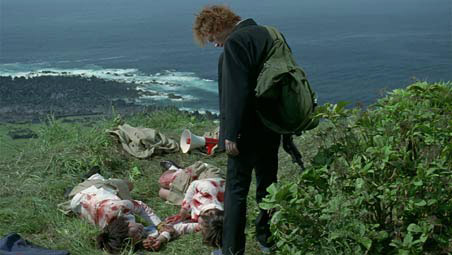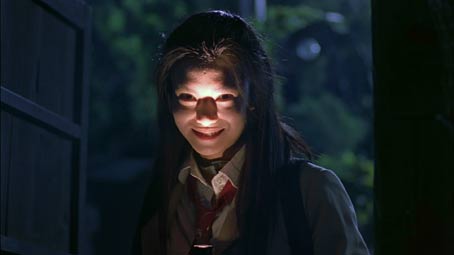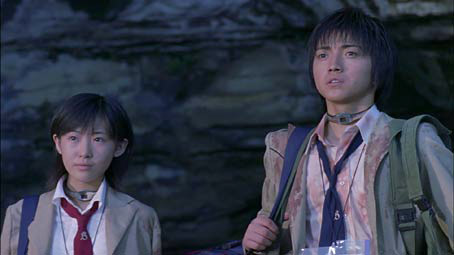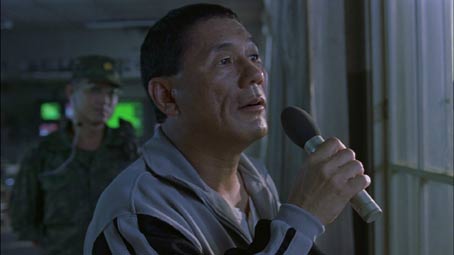|
At a time when just about every successful film from anywhere gets artistically castrated by a Hollywood remake, it's heartening to think that there are still a few out there that are in no immediate danger of being sucked into that machine. Right at the moment, Srdjan Spasojevic's A Serbian Film seems an unlikely candidate, but there's one film that not only seems immune from even the prospect of such a retooling, but a full ten years after it was made has yet to receive an official stateside release, despite its success elsewhere and its status as one of THE cult movies of the first decade of the twenty-first century. Mind you, given the subject matter it's hardly surprising, as what the film depicts in the name of entertainment and social commentary remains a very real and recurring nightmare across the Atlantic.*
I'm assuming, of course, that this is old news for most of you, as there's a good chance that even those who have never seen Battle Royale will have at least heard of it and be aware of its content, or at least its most controversial aspect. For those select few for whom it has remained little more than a title, see if you can spot the problem from the following plot summary.

In an alternative reality Japan on the brink of the new millennium, youth delinquency and violence within the school system has degenerated to such a degree that the government has passed the Millennium Educational Reform Act, aka Battle Royale, in which a randomly selected class of junior high school students is transported to an uninhabited island, armed with weapons of varying effectiveness, and given three days to kill each other until only one is left standing. To ensure their participation they are fitted with necklaces that explode if any attempt is made to remove them and are collectively detonated if more than one of them is still alive at the contest's conclusion. The film follows the fate of Shiroiwa Junior High School Class 3-B as they are rendered unconscious, transported to the island, and pitted against each other in a ruthless and violent fight to the death.
As a real-world concept this may take some swallowing, but as presented in the film it feels oddly credible, a desperate measure taken by an increasingly disillusioned and dispassionate adult population against a youth they have lost all real authority over and have come to fear.** There is never the sense that this is intended as a deterrent, more an extreme act of revenge by a frightened and insecure populace, one inflicted on those they blame for a breakdown of age-old societal traditions of authority and respect. And while the contest takes place in isolation, effectively shielding the public from the extremity of the violence, its winner becomes the subject of frenzied media attention, captured at the start in the spectacularly creepy image of an innocent-looking but bloodied young schoolgirl survivor of a previous competition, clutching a doll and smiling for the press like a small child who has just amused herself by opening the gates to hell.
Although based on the bestselling novel by Takami Kôshun, Battle Royale feels every inch a live action manga adaptation,*** particularly in the reality-stretching elements of its plot, the bloodiness of the violence, and the suddenness and severity of the emotional and tonal switches. Here the sentimentally emotional and the confrontationally brutal are interchangeable in the twitch of a trigger finger, a high school drama in which the stock elements of relationships, jealousies, peer pressure and cliques are punctuated by bullets, blades, stun guns and arrows. An exploitation thriller yes, but one whose layered social commentary and metaphoric depth really do put it in a class of its own (no pun intended). That the students so quickly take to murdering their classmates functions less as social realism than a symbolic extension of the petty conflicts that are an everyday aspect of schoolyard life. The makeup of Class 3-B includes the sort of character spread you'll find in (movie) high school classes the world over, archetypes whose skill at the game lies as much in their self-image as their survival instincts, and whose fight for existence is emboldened to the point where jealousy and spite become motives for murder, true feelings are only exposed at the point of death, and misunderstood intentions prove lethal to both parties.

A likely hero and heroine are signposted at an early stage in the shape of reluctant participants Nanahara and Nakagawa, their previously suppressed attraction for each other uniting them in a determination to both survive a game that can only have one winner. The manner in which the students face their predicament proves to be largely dependent on their dominant personality trait – killing her classmates comes disturbingly easy to self-centred beauty Mitsuko, a seemingly natural extension of the contempt in which she already holds them, while the class boffin trio of Mimura, Iijiama and Yutaka retreat from the fight to hack into the game system and construct a bomb to take out its fortified command centre. Two couples kill themselves rather than participate, while optimistic duo Yukio and Yumiko attempt to rally their classmates and are slaughtered for their trouble. The relationship metaphor hits an extraordinary peak with the cheerful group of girls who drop out of the game and set up home in an abandoned lighthouse, where the damaging effects of jealousy and suspicion prompt their small but seemingly tight community to self-destruct in a hail of accusatory gunfire, compacting weeks of argument and relationship breakdown into a few lethal seconds.
Stirring the mix are two transfer students who, unlike the others, have enlisted voluntarily. A previous competition winner back for a second shot at the title, Kawada's true motives only become clear once he teams up with Nanahara and Nakagawa, but spiky-haired sociopath Kiriyama appears to have joined up for the sheer fun of the hunt and is as smart as he is deadly, the timing of his appearances and the glee with which he kills making him both the most fascinating and infuriating player in the game.****
Running the show is Class 3-B's former teacher Kitano, who quit after being stabbed in a school hallway and whose weariness at the increasing disrespect shown by his students (and, it turns out, his own daughter) has hardened him the degree that he kills one of them simply for whispering during the game's induction. As played by the ever-reliable Kitano Takeshi, he proves both oddly enigmatic and a more complicated than first impressions suggest. This is particularly true of his quiet affection for Nakagawa, which manifests itself in almost surrealistic fashion when he appears unexpectedly before her and offers his umbrella to shelter from the rain. Having just narrowly escaped Mitsuko's pistol and with the wounded Nanahara lying at her feet, this is by then the least of her worries.

All of which would only count for so much if the film didn't deliver on its action thriller credentials, but so good is it on this front that it could (and for many does) safely trade on this element alone. Thrillingly shot and edited, Battle Royale has all the explosive energy of a debut work of a dynamic young newcomer, but was actually the sixtieth feature by the then 70-year-old Fukasaku Kinji, director of string of belting yakuza films in the 1960s and previously best known to western audiences for handling the Japanese sequences in the 1970 recounting of the attack on Pearl Harbour, Tora! Tora! Tora!.
The blisteringly staged conflict is coupled with a density of incident and a sleight-of-hand filmic economy (that the students have been drugged on their coach trip is communicated simply by the positions in which they are sleeping) to move the story forward at a sometimes breathless pace, while the socio-political layering makes almost every scene worthy of analytical study. Feminists should have a ball with the sequence in which female student Chigusa responds to male classmate Niida's clumsy attempts to force himself on her by stabbing him violently in the crotch, or the almost Dante-esque image of Mitsuko dressing and walking coldly away from the naked and slaughtered bodies of two of her male classmates. The inky black humour tends to be more culturally based – Kitano's late story exercise to music is a famous radio callisthenics program that is broadcast daily in Japan, while the hilariously upbeat introduction video, in which an impossibly chirpy female presenter cheerfully outlines the rules of the game, will be instantly recognisable to anyone who's spent any time in front of a TV in a Japanese hotel room. Such dark frivolity is quickly balanced by the sequence in which the students are individually called up and sent out into the game, their reactions and parting goodbyes vividly capturing their terror at what lies ahead, and their realisation that they are probably heading out to their deaths.
Some have criticised the almost strident use of classical and specifically composed music, which is at its least subtle during the shock moment crescendos, but in a film that deals in such extremes of action and emotion it feels oddly appropriate, and plays well as an extension of the Prisoner-style public address broadcasts (the film even shares one of the series' most recognisable pieces in Strauss' Radetzky March, Op. 228), whose music sometimes counterpoints the action to blackly comic effect.

Battle Royale remains an object lesson in what cult exploitation cinema can and at its best should be. Compelling as drama, economic in its storytelling, and electrifying and purposeful in the staging of its violence, its sharp social subtext and savvy use of metaphor give it a substance and replay value that time has done nothing to diminish. Lord of the Flies for the sensation-hardened reality television age, it remains a controversial and for some even confrontational work, but for all the right reasons, and I'll enthusiastically argue its case as great and important cinema until the ammunition is exhausted, the bullet holes have dried, and there's only bloodied, exhausted and morally fractured one of us left standing.
Six months after the initial shoot, Fukasaku reassembled many of the young cast to shoot a new bookend sequence, tinker with the effects and the opening credits, and re-edit existing scenes. The resulting Special Edition, included here on disc 2, does not for the most part differ substantially from the original cut, with minor changes to the editing rhythm of some sequences and CG enhancement of effects being the sort of thing that only serious devotees are likely to pick up on. The opening credits and introduction have been visually spruced up, and the film now concludes with three 'requiems', which though interesting in themselves feel a little bit like deleted and extended scenes that have been tagged onto an ending that works far better when it cuts straight to the credits. The newly shot sequence has the class taking part in a basketball match which – with one notable exception – unites them and fills them with the very enthusiasm that they appear to have lost for school and life in general. As a framing device it does the film no harm, which is more than can be said for the flashbacks to the match that intermittently pop up during the rest of the film, disrupting the flow of scenes that work far better in their original form. A new sequence in which the infant Mitsuko pushes a man down the stairs after he makes sexual advances towards her fits well with the existing flashbacks, and adds to the sense that the root of these kids' problems lies with the adults who now fear them (something that is more pronounced in the original novel).
This may not be the film you'll use to dazzle friends with the wonders of Blu-ray sharpness, but the transfer here is still several notches above previous DVD versions. Consistency is an issue and how much of this is down to the original film materials is hard to say, but it does result in some variance in image sharpness, with a noticeable softness to some of the more dimly lit shots and the otherwise punchy black levels slipping sharply to mid-greys in some of the darker scenes. But elsewhere the image has a very pleasing crispness and textural richness, and intermittently – the wide shot of waves crashing on the shore at 44:40 on the Special Edition is a good example – we're well aware that we're watching a Blu-ray rather than the DVD. Comparisons with Tartan's earlier NTSC DVD release show a sharper image with better colour and more detail at both ends of the subtler contrast range, and brightness of the earlier discs is toned down here. The transfer itself is spotless.

You can play the film in Dolby 2.0 stereo, but why would you want to when the alternative is a thumping DTS-HD 5.1 mix? The 5.1 track on the DVD was impressive and the DTS track here takes its cue from that. Sound effects and music have a lovely fullness and clarity (the effects were re-recorded for the Special Edition and there's a suspicion that the original cut has been retooled accordingly), but it's the LFE bass that really makes its mark, giving a serious kick to everything from helicopter rotors to gunfire to the crashing of surf on rocks. There's precise separation across the whole sound stage and the use of the surrounds is as inclusive as on previous 5.1 tracks, particularly in a fire-fight or falling rain. The only downside is that the original dialogue – which has obviously not been re-recorded – is often fighting and occasionally losing a battle on volume and clarity to the music and effects. Get the volume right for the dialogue and you're likely to be forking out for new windows once the gunfire starts.
The extras are spread over the three discs in the set, some on the two Blu-rays one which the two versions of the film sit, the rest on a DVD. All are in standard resolution. Some if not all will be familiar to ardent fans.
Disc 1: The Theatrical Cut
Trailer (1:51)
The snappily assembled original Japanese trailer that only hints at the level of violence within the film.
The Making of Battle Royale: The Experience of 42 High School Students (52:32)
Kicking off with an on-set celebration of director Fukasaku's 70th birthday, this enjoyable if typically rag-tag assembly of behind-the-scenes footage demonstrates that he's lost none of his youthful energy, his sometimes very physical involvement drawing repeated reactions of disbelief from his young cast. It also becomes clear that he's both a hard taskmaster and a determined perfectionist, repeating actions and shots until they're just how he wants them. Caught between takes the young actors (whose average age was 15) appear cheerfully unaffected by the violence they are portraying, and most confess that they'd do anything to avoid killing others if forced to take part in a real Battle Royale. In a particularly intriguing interview snippet, Fukasaku talks about his own student protest days and wishes they'd had weapons to combat police aggression.
Disc 2: The Special Edition
Special Edition Theatrical Trailer (1:05)
Another nifty sell, "dedicated to all those graduating from junior high this spring."
TV Spot: Tarantino Version (0:32)
Another short trailer, this one with a clip of the pointy chinned wonder saying "I loved Battle Royale."
Shooting the Special Edition (9:01)
DV footage behind the scenes of the basketball game shoot, whose young cast are still impressed by their septuagenarian director's energy. Fun to note that hand-held shots on the court were achieved by pushing the camera operator around on rollerblades.

Kitano Takeshi interview (11:51)
Shot handheld on DV in what looks like Kitano's trailer during the shoot, this proves an amiable and interesting chat with the famed actor, director and media superstar, who talks about his role, his character, working with the young cast, Fukasaku's direction ("he's twice as fast as me"), and his own schooldays.
Conducting Battle Royale with the Warsaw National Philharmonic Orchestra (7:27)
The title tells all as a very animated Amano Masamichi conducts the Warsaw National Philharmonic during the recording of a number of key pieces from the score, all shot on DV from the back of the hall. Usefully the individual works are titled to help locate their position within the film. This does make you appreciate the emotional content of Amano's own compositions all the more.
The Correct Way to Make Battle Royale: Birthday Version (3:09)
The chirpy presenter of the induction video does a special version for Fukasaku's 70th birthday, which instructs the crew how to shoot the film properly and includes wobbly footage of the cast and crew singing Happy Birthday. Rather fun.
Tokyo International Film Festival Presentation (4:37)
Fukasaku and his main cast on stage addressing the audience before the festival screening. The film's 15 rating in Japan – which the director and Takeshi both opposed – gets mentioned more than once here.
Disc 3: Extra Features DVD
Premiere Press Conference (12:02)
Fukasaku, his cast (all in costume and makeup) and Kôshun Takami, writer of the novel on which the film is based, talk to the press on the penultimate day of the film's production. The cast talk about their roles and praise their director, the audience applauds politely and Takeshi provides the laughs.
Opening Day at Marunouchi Toei Movie Theatre (14:26)
Fukasaku and several of the cast address a packed cinema of press and primarily young filmgoers before the premiere of the film.
The Slaughter of 42 High School Students (10:09)
A shorter companion to the similarly titled behind-the-scenes documentary above that uses footage not included in that version. Once again Fukasaku's energy and perfectionism comes through in spades, and there's a musical number from one of the cast, some engagingly good natured gooning about, and the cast reacting to a first cut of the induction scene.
A collection of promos include an action-packed TV Ad (0:34), a TV Promo (1:49), which is almost identical to the theatrical trailer (including the violence), one short and one long and violent TV Commercial (3:41 total), and two Promos (0:16 and 0:37).
The Correct Way to Fight in Battle Royale (2:35)
The cheerful induction video in total and at pristine video quality.
Royale Rehearsals (7:11)
Wobbly video footage of the cast in vocal and action rehearsal on a number of sequences.
Masamichi Amano conducts Battle Royale (9:46)
A companion piece to the extra on disc 2 that covers different musical pieces.
Special Effects Comparison (4:17)
An always welcome breakdown of how some of the effects were composited, most (though not all) of them involving violence.
Behind the Scenes Featurette (12:09)
The EPK for the film, a mixture of behind-the-scenes footage, brief upbeat interviews and distracting visual trickery.
Filming On Set (11:00)
A trimmed down version of the documentary on disc 1, some of which is unique to this featurette.
Trailer Gallery (23:09)
A seductive collection of trailers for Fukasaku's earlier Yakuza films.
Also included in the release version are a poster, postcards, a comic and 2 booklets that did not accompany the review disc.
You can keep the 2003 sequel, Battle Royale II: Requiem (which was begun by Fukasaku and completed by his son Kenta after his father's death), the upcoming 3D retooling (I know, can you believe it?) and any prospect of a remake from anywhere in the world – I'll still take the original in all its kinetic two-dimensional glory. The film has had a number of DVD releases both here and across the water(s), but Arrow's three-disc Blu-ray Limited Edition has to be the best yet, featuring a solid transfer, a thumping soundtrack (although my disappointment and the difference in volume between the effects and the dialogue remains) and pretty much all of the extras from previous DVD releases. Violently recommended.
* Back in 2006 an American remake was proposed by producers Neil Moritz and Roy Lee, which prompted howls of dismay worldwide from fans of the original. The April 2007 massacre at Virginia Tech appears to have quashed any chance of the project being revived in the near future.
** The alternate reality of the original novel was one in which Japan had been victorious in WW2, which casts the storyline in a very different light.
*** As it happens, the novel was adapted into manga form by original author Koushun Takami, with artwork by Masayuki Taguchi. It was first published in November 2000, shortly before the release of film.
**** The novel provides back-story information on Kiriyama that helps explain why he behaves as he does. Intriguing though this is, his film character doesn't need this to make his mark.
The Japanese convention of surname first has been used throughout this review.
|